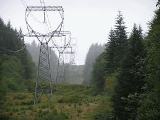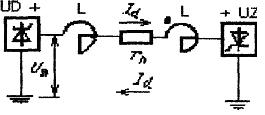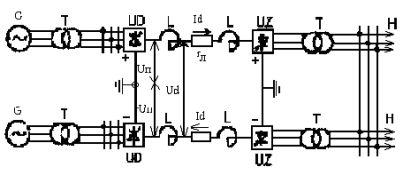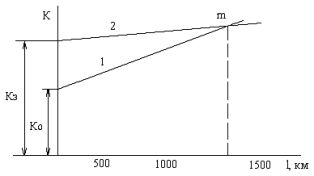Direct current electrical wires
 The advantages of direct current transmission lines are as follows:
The advantages of direct current transmission lines are as follows:
1. The limit of transmitted power along the line does not depend on its length and is much greater than that of alternating current power lines;
2. The concept of a static stability limit characteristic of overhead AC transmission lines is eliminated;
3. Electrical systems connected overhead transmission lines with direct current may operate asynchronously or with different frequencies;
4. Only two wires are required instead of three, or even one if you use ground as the second.
In fig. 1. presented bipolar DC transmission circuit ("Two poles - ground").
In this figure, UD and UZ, converter (rectifier and inverter) substations; L — reactor or filter to reduce the influence of high harmonics, voltage ripples and emergency currents; rl is the line resistance; G, T — generators and transformers.
The generation and consumption of electricity is carried out on alternating current.
Fig. 1. DC transmission circuit in emergency mode
The main elements of the permanent line:
1.Controlled high voltage rectifiers from which the converter substation circuit is assembled.
2. Controlled high voltage inverters from which the circuit of the converter substation is also assembled.
The scheme of the inverter substation does not fundamentally differ from the scheme of the rectifier substation, since the rectifiers are reversible. The only difference is that compensating devices, capacitors or synchronous compensators must be installed at the inverter substation to provide the inverters with reactive power, which is about 50 ... 60% of the transmitted active power.
The midpoints of the two converter stations in bipolar transmission are grounded and the poles are isolated.
The pole voltage UP is equal to the pole-to-ground voltage. For example, in the Volgograd-Donbass power transmission, the voltage of the pole to the ground is +400 kV, and the voltage of the second pole is 400 kV. Voltage Ud between poles 800 kV. The transmission can be divided into two independent half-circuits. In normal mode, with equal points in half-circuits, the current through the ground is close to zero. Both transmission half-circuits can operate autonomously and in case of failure of one pole, half of the power can be transmitted through the other pole with a return through the ground.
In the event of a single-pole or single-half-circuit fault, the second half-circuit can operate on a single-pole circuit.

Rice. 2. Direct current transmission scheme in emergency mode
In single-pole transmission, one pole is grounded and there is one wire insulated from ground. The second wire is either grounded on both sides of the transmission or is missing.Such a grounded second wire is used in cases where the use of current in the ground is unacceptable (for example, when entering large cities). As a rule, a unipolar transmission circuit can consist of one wire and ground, and a bipolar one can consist of two wires. The experience of long-term transmission of direct current through the ground up to 1200 A.
Unipolar circuits are used to transmit small powers up to 100 … 200 MW over short distances. It is recommended to transmit large powers over long distances using bipolar circuits.
Converter substations, due to the complex and expensive equipment, significantly increase the cost of DC transmission. At the same time, the DC line itself is cheaper than AC, due to fewer wires, insulators, fittings and lighter supports.
The energy transfer capacity of the permanent line is determined by the value and voltage difference at the ends of the line, it is limited by the active resistances of the lines and end devices, as well as by the power of the converting substations.
The carrying capacity of the DC line is much higher than that of the AC line.
The total power of the bipolar transmission of the Volgograd-Donbass line with voltage Ud = 800 kV is 720 MW. The world's largest line Ekibastuz — Center was put into operation with UP = ± 750 kV, voltage between poles Ud = 1500 kV and length 2500 km. The power capacity can be increased to 6000 MW.
The main application area of direct current lines is the transmission of large power over long distances. However, the special properties of these lines allow them to be used successfully in other cases as well.For example, direct current lines are effective when it is necessary to cross sea straits, as well as to connect asynchronous systems or systems operating at different frequencies (so-called DC connections).
Along with high and ultra high voltage direct current lines, low and medium voltage direct current lines are also used in military affairs.
The following voltages are common: low voltage — 6, 12, 24, 36.48, 60 volts, medium voltage — 110, 220, 400 volts.
For all voltages, DC lines have the following advantages:
1. They do not require a stability calculation.
2. The voltage in such lines is more uniform, since in steady state they do not generate reactive power.
3. Constructions of direct current lines are simpler than alternating ones: fewer strings of insulators, less consumption of metal.
4. The direction of power flow can be reversed (reversible lines).
Disadvantages:
1. The need to build complex terminal substations with a large number of voltage converters and auxiliary equipment. Rectifiers and inverters are known to significantly distort the voltage waveform on the AC side. Therefore, it is necessary to install powerful smoothing devices, which significantly reduces reliability.
2. Power selection from the DC line is still difficult.
3. In direct current lines, it is required that the polarity and voltage at both ends be approximately the same before switching on.
Thus, it is possible to conclude that due to the high costs of k0 (Fig.3), the construction of power lines with direct current (curve 2) becomes economically feasible only at large distances equal to about 1000 ... 1200 km (point m).
Rice. 3. The dependence of capital costs k on the length of the line l for alternating current — 1 and for direct current — 2
I. I. Meshteryakov


